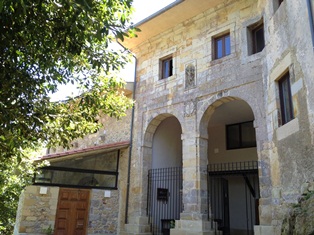 Padres Capuchinos of Montehano Monastery
Padres Capuchinos of Montehano Monastery
Location: Escalante, Montehano, on the road from Cicero to Santoña (CA-241). The style is late gothic and it was declared Bien de Interés Cultural in 1981. This monastery is situated in the heart of Santoña´s marshes, in the Hano mount. The architectonic austerity mixes with the scenery in an environment that conforms one of the most outstanding marsh ecosystems on the Cantabrian coast. The origins of this monastery date back the lower Middle Ages. The Guevara family held unlawfully the tradition since 1441. Nevertheless, there are reliable news in which the monastery life is evident in the XIV century. Best part of its estructural achitecture dates from the XVII century, time in which the monastery went through a remodelling state. From the beguining this was a religious enclosure regulated by the Franciscan order. The monastery had the privilage of the ship ownership, granted by the Catholic Kings in the year 1491. The marshes runned the Hano islet, this is why the monks were obliged to move by boat through the Hano bridge. The monastery´s history is marked by the numerous law suits with the Escalante village: secular law suits of the firewood within the mountain and the ownership of the marshes. With the ecclesiastical confiscation of Mendizabal, the building experimented a halt in 1835. The building then went to private hands. at the end of the XIX century, its owner, the Count of Casa Puente, donates it to the Santander bishopric. From the beguining of the XX century, the monastery is inhabited by monks of the Capuchin Brotherhood Order, who recovered the religious life in the building. Mrs. Bárbara de Blomberg, mother of D. Juan of Austria is burried here.
Ver en mapa
Guevara Palace
situated in the Mayor street, the building dates from the XVII century, of rectangular floor, with two levels and framewaorks on square pillars. The weapons within the Palace belonged to the Guevara family, counts of Escalante since 1627 and the Santelices family, marquis of Chiloeches.
Ver en mapa
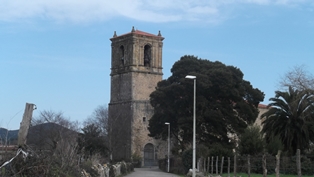 Santa Cruz Church
Santa Cruz Church
Situation: Escalante. Accessible by the road S-402, in front of the Clarisas monastery. The origin of this church dates back to the XIV century, time in which the building was linked to the Ceballos and Guevara family. The church was built between the XVI and XVII centuries, the Santiago´s chapel being the oldest part, with a dome that is supported by columns. Teh church is formed by a nave with side chapels and a high door and bells in the tower, are some of the most emblematic elements. The tower´s style is baroque, built in 1702. The tower has three parts and a door. Its use was, as well as calling for mass, to mark the village´s everyday´s life, marking the working hours, the neighbourhood meetings and even as a fire alarm. In its interior we can find a magnificent churrigueresque altarpiece from the year 1730, big and of very good quality. It is formed by a central body with three sides and an attic. The sanctuary is of great importance, two levels and octagonal floor.
Ver en mapa
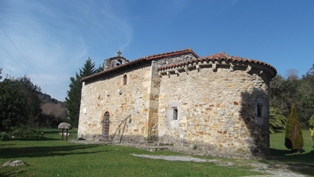 San Román shrine
San Román shrine
Situation: Escalante. On the road S-402 which links Escalante with Noja. It was declared bien de Interés Cultural in 1986. This little an humble shrine is a valuable sample of the limited Romanesque style on the Cantabrian coast, with only one nave of rectangular floor and a deep presbytery that ends in the circular apse, and decorated with animals figures and geometrical shapes. This depth in the apse, differentiated in the nave and in the semicircular area, indicates a late chronology of the Romanesque (towards the year 1200). The shrine is completed by a small bell wall with a simple arched window . The simple access door is situated in the south wall, supported by geometrical shapes decorated columns. Built with masonry on walls and corners, ledge and arches. The nave is covered with wood. In its interior there are beautiful capitals and a medieval sepulchre. In the evangelical side column there is a representation of the Virgin Mary and child. The image is a late version from the beguining of the XII century. It is a very stylished character, vertical, the lines of the dress, the placing of the feet, the shape of the shoes, etc. The church is decicated to San Román, a Saint closely linked to the village of San Benito. This devotion is related to the monastery of Santa María del Puerto in Santoña, which depends from San Román. It is situated in a fortified enclosure with a garden where laurel, wild roses, cypresses and pines are planted.
Ver en mapa
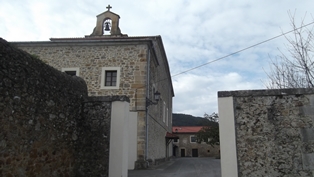 Santa Clara Convent
Santa Clara Convent
Ver en mapa
San Roque Shrine
Situation: besides the Santa Clara Convent. From the XVII century. Neogothic style.
Ver en mapa
Calle San Juan ensemble
Beautiful line of typical houses, with cantabrian balconies. There are houses from the XVIII century till the XX century.
Ver en mapa
Town Hall
Magnificent building with elements from different times. Probably the oldest element is a pointed arch with long domes from the XV century. The fachade, masonry, is from the XVI century with wide arches.
Ver en mapa
Agüero House
situated in the Mayor street, it is a group formed by the house of this lineage, the Nuestra Señora de Consolación shrine and the place where the old pilgrims hospital is. The shrine was founded at the beguining of the XIV century and it was refurbished around 1950. Nothing is left of the pilgrims hospital.The Agüero house, is a building built in the second half of the XIX century.
Ver en mapa
The Guevara Palace
situated in the Mayor street, the building was built in the XVII century, of rectangular floor, with two levels and armours on square columns. The weapons within the Palace are from the Agüero Family, counts of Escalante, since 1627 and the Santelices family, marquis of Chiloeches.
Ver en mapa
Casa de Lamadrid
Blazoned house from the XVI century, situated in the Ramón y Cajal street. It is formed by two masonry levels and arched doors. The blazon is in the corner with the family´s surname.
Ver en mapa
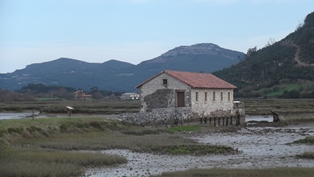 Cerroja Watermill
Cerroja Watermill
Situation: It is accessed trhough the roundabout on the road CA-148, following the indicators. It is a tide watermill, which origins probably are before the year 1047, as it is testified by a document that talks about the construction. This makes the watermill the oldest in Europe. The watermill used the tides so the stored water could be released, moving the stones to mill the cereals. These flours were the food for Escalante and the whole region. It functioned till the middle of the XX century.
Ver en mapa

Padres Capuchinos of Montehano Monastery
Location: Escalante, Montehano, on the road from Cicero to Santoña (CA-241). The style is late gothic and it was declared Bien de Interés Cultural in 1981. This monastery is situated in the heart of Santoña´s marshes, in the Hano mount. The architectonic austerity mixes with the scenery in an environment that conforms one of the most outstanding marsh ecosystems on the Cantabrian coast. The origins of this monastery date back the lower Middle Ages. The Guevara family held unlawfully the tradition since 1441. Nevertheless, there are reliable news in which the monastery life is evident in the XIV century. Best part of its estructural achitecture dates from the XVII century, time in which the monastery went through a remodelling state. From the beguining this was a religious enclosure regulated by the Franciscan order. The monastery had the privilage of the ship ownership, granted by the Catholic Kings in the year 1491. The marshes runned the Hano islet, this is why the monks were obliged to move by boat through the Hano bridge. The monastery´s history is marked by the numerous law suits with the Escalante village: secular law suits of the firewood within the mountain and the ownership of the marshes. With the ecclesiastical confiscation of Mendizabal, the building experimented a halt in 1835. The building then went to private hands. at the end of the XIX century, its owner, the Count of Casa Puente, donates it to the Santander bishopric. From the beguining of the XX century, the monastery is inhabited by monks of the Capuchin Brotherhood Order, who recovered the religious life in the building. Mrs. Bárbara de Blomberg, mother of D. Juan of Austria is burried here.
Ver en mapa
Location: Escalante, Montehano, on the road from Cicero to Santoña (CA-241). The style is late gothic and it was declared Bien de Interés Cultural in 1981. This monastery is situated in the heart of Santoña´s marshes, in the Hano mount. The architectonic austerity mixes with the scenery in an environment that conforms one of the most outstanding marsh ecosystems on the Cantabrian coast. The origins of this monastery date back the lower Middle Ages. The Guevara family held unlawfully the tradition since 1441. Nevertheless, there are reliable news in which the monastery life is evident in the XIV century. Best part of its estructural achitecture dates from the XVII century, time in which the monastery went through a remodelling state. From the beguining this was a religious enclosure regulated by the Franciscan order. The monastery had the privilage of the ship ownership, granted by the Catholic Kings in the year 1491. The marshes runned the Hano islet, this is why the monks were obliged to move by boat through the Hano bridge. The monastery´s history is marked by the numerous law suits with the Escalante village: secular law suits of the firewood within the mountain and the ownership of the marshes. With the ecclesiastical confiscation of Mendizabal, the building experimented a halt in 1835. The building then went to private hands. at the end of the XIX century, its owner, the Count of Casa Puente, donates it to the Santander bishopric. From the beguining of the XX century, the monastery is inhabited by monks of the Capuchin Brotherhood Order, who recovered the religious life in the building. Mrs. Bárbara de Blomberg, mother of D. Juan of Austria is burried here.
Ver en mapa
Guevara Palace
situated in the Mayor street, the building dates from the XVII century, of rectangular floor, with two levels and framewaorks on square pillars. The weapons within the Palace belonged to the Guevara family, counts of Escalante since 1627 and the Santelices family, marquis of Chiloeches.
Ver en mapa
situated in the Mayor street, the building dates from the XVII century, of rectangular floor, with two levels and framewaorks on square pillars. The weapons within the Palace belonged to the Guevara family, counts of Escalante since 1627 and the Santelices family, marquis of Chiloeches.
Ver en mapa

Santa Cruz Church
Situation: Escalante. Accessible by the road S-402, in front of the Clarisas monastery. The origin of this church dates back to the XIV century, time in which the building was linked to the Ceballos and Guevara family. The church was built between the XVI and XVII centuries, the Santiago´s chapel being the oldest part, with a dome that is supported by columns. Teh church is formed by a nave with side chapels and a high door and bells in the tower, are some of the most emblematic elements. The tower´s style is baroque, built in 1702. The tower has three parts and a door. Its use was, as well as calling for mass, to mark the village´s everyday´s life, marking the working hours, the neighbourhood meetings and even as a fire alarm. In its interior we can find a magnificent churrigueresque altarpiece from the year 1730, big and of very good quality. It is formed by a central body with three sides and an attic. The sanctuary is of great importance, two levels and octagonal floor.
Ver en mapa
Situation: Escalante. Accessible by the road S-402, in front of the Clarisas monastery. The origin of this church dates back to the XIV century, time in which the building was linked to the Ceballos and Guevara family. The church was built between the XVI and XVII centuries, the Santiago´s chapel being the oldest part, with a dome that is supported by columns. Teh church is formed by a nave with side chapels and a high door and bells in the tower, are some of the most emblematic elements. The tower´s style is baroque, built in 1702. The tower has three parts and a door. Its use was, as well as calling for mass, to mark the village´s everyday´s life, marking the working hours, the neighbourhood meetings and even as a fire alarm. In its interior we can find a magnificent churrigueresque altarpiece from the year 1730, big and of very good quality. It is formed by a central body with three sides and an attic. The sanctuary is of great importance, two levels and octagonal floor.
Ver en mapa

San Román shrine
Situation: Escalante. On the road S-402 which links Escalante with Noja. It was declared bien de Interés Cultural in 1986. This little an humble shrine is a valuable sample of the limited Romanesque style on the Cantabrian coast, with only one nave of rectangular floor and a deep presbytery that ends in the circular apse, and decorated with animals figures and geometrical shapes. This depth in the apse, differentiated in the nave and in the semicircular area, indicates a late chronology of the Romanesque (towards the year 1200). The shrine is completed by a small bell wall with a simple arched window . The simple access door is situated in the south wall, supported by geometrical shapes decorated columns. Built with masonry on walls and corners, ledge and arches. The nave is covered with wood. In its interior there are beautiful capitals and a medieval sepulchre. In the evangelical side column there is a representation of the Virgin Mary and child. The image is a late version from the beguining of the XII century. It is a very stylished character, vertical, the lines of the dress, the placing of the feet, the shape of the shoes, etc. The church is decicated to San Román, a Saint closely linked to the village of San Benito. This devotion is related to the monastery of Santa María del Puerto in Santoña, which depends from San Román. It is situated in a fortified enclosure with a garden where laurel, wild roses, cypresses and pines are planted.
Ver en mapa
Situation: Escalante. On the road S-402 which links Escalante with Noja. It was declared bien de Interés Cultural in 1986. This little an humble shrine is a valuable sample of the limited Romanesque style on the Cantabrian coast, with only one nave of rectangular floor and a deep presbytery that ends in the circular apse, and decorated with animals figures and geometrical shapes. This depth in the apse, differentiated in the nave and in the semicircular area, indicates a late chronology of the Romanesque (towards the year 1200). The shrine is completed by a small bell wall with a simple arched window . The simple access door is situated in the south wall, supported by geometrical shapes decorated columns. Built with masonry on walls and corners, ledge and arches. The nave is covered with wood. In its interior there are beautiful capitals and a medieval sepulchre. In the evangelical side column there is a representation of the Virgin Mary and child. The image is a late version from the beguining of the XII century. It is a very stylished character, vertical, the lines of the dress, the placing of the feet, the shape of the shoes, etc. The church is decicated to San Román, a Saint closely linked to the village of San Benito. This devotion is related to the monastery of Santa María del Puerto in Santoña, which depends from San Román. It is situated in a fortified enclosure with a garden where laurel, wild roses, cypresses and pines are planted.
Ver en mapa

Santa Clara Convent
Ver en mapa
Ver en mapa
San Roque Shrine
Situation: besides the Santa Clara Convent. From the XVII century. Neogothic style.
Ver en mapa
Situation: besides the Santa Clara Convent. From the XVII century. Neogothic style.
Ver en mapa
Calle San Juan ensemble
Beautiful line of typical houses, with cantabrian balconies. There are houses from the XVIII century till the XX century.
Ver en mapa
Beautiful line of typical houses, with cantabrian balconies. There are houses from the XVIII century till the XX century.
Ver en mapa
Town Hall
Magnificent building with elements from different times. Probably the oldest element is a pointed arch with long domes from the XV century. The fachade, masonry, is from the XVI century with wide arches.
Ver en mapa
Magnificent building with elements from different times. Probably the oldest element is a pointed arch with long domes from the XV century. The fachade, masonry, is from the XVI century with wide arches.
Ver en mapa
Agüero House
situated in the Mayor street, it is a group formed by the house of this lineage, the Nuestra Señora de Consolación shrine and the place where the old pilgrims hospital is. The shrine was founded at the beguining of the XIV century and it was refurbished around 1950. Nothing is left of the pilgrims hospital.The Agüero house, is a building built in the second half of the XIX century.
Ver en mapa
situated in the Mayor street, it is a group formed by the house of this lineage, the Nuestra Señora de Consolación shrine and the place where the old pilgrims hospital is. The shrine was founded at the beguining of the XIV century and it was refurbished around 1950. Nothing is left of the pilgrims hospital.The Agüero house, is a building built in the second half of the XIX century.
Ver en mapa
The Guevara Palace
situated in the Mayor street, the building was built in the XVII century, of rectangular floor, with two levels and armours on square columns. The weapons within the Palace are from the Agüero Family, counts of Escalante, since 1627 and the Santelices family, marquis of Chiloeches.
Ver en mapa
situated in the Mayor street, the building was built in the XVII century, of rectangular floor, with two levels and armours on square columns. The weapons within the Palace are from the Agüero Family, counts of Escalante, since 1627 and the Santelices family, marquis of Chiloeches.
Ver en mapa
Casa de Lamadrid
Blazoned house from the XVI century, situated in the Ramón y Cajal street. It is formed by two masonry levels and arched doors. The blazon is in the corner with the family´s surname.Ver en mapa

Cerroja Watermill
Situation: It is accessed trhough the roundabout on the road CA-148, following the indicators. It is a tide watermill, which origins probably are before the year 1047, as it is testified by a document that talks about the construction. This makes the watermill the oldest in Europe. The watermill used the tides so the stored water could be released, moving the stones to mill the cereals. These flours were the food for Escalante and the whole region. It functioned till the middle of the XX century.
Ver en mapa
Situation: It is accessed trhough the roundabout on the road CA-148, following the indicators. It is a tide watermill, which origins probably are before the year 1047, as it is testified by a document that talks about the construction. This makes the watermill the oldest in Europe. The watermill used the tides so the stored water could be released, moving the stones to mill the cereals. These flours were the food for Escalante and the whole region. It functioned till the middle of the XX century.
Ver en mapa




